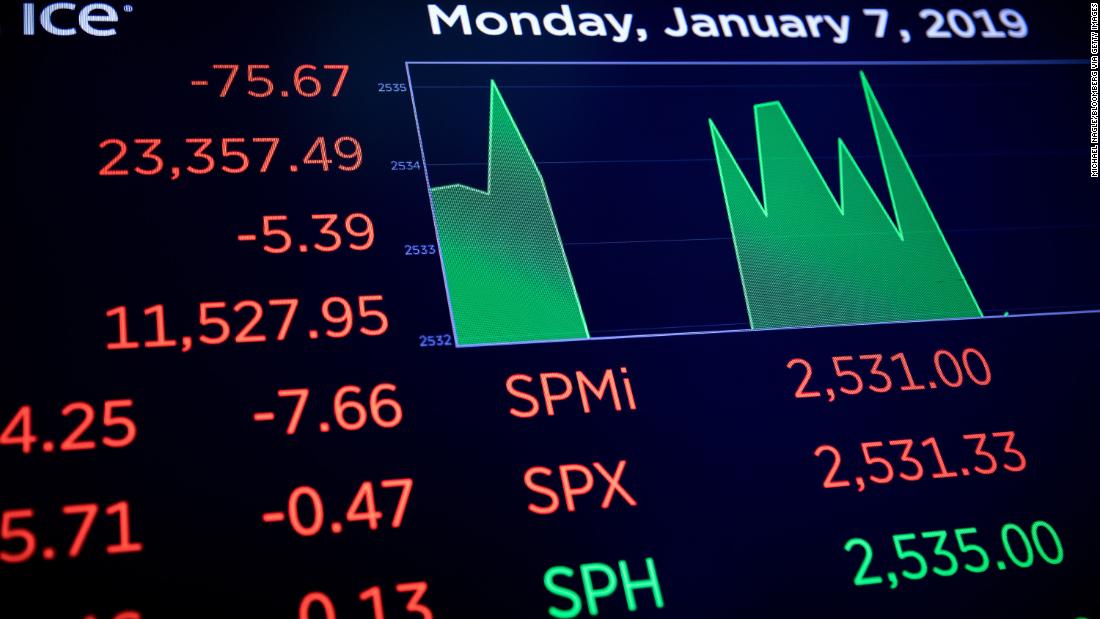
The Dow has spiked about 2,100 points, or 10%, since Christmas Eve. Oil prices are up twice as much. Even risky junk bonds have joined the party.
The across-the-board recovery continued Wednesday, and the Dow flirted with the 24,000 level. The S&P 500 is trying for its first four-day win streak since September.
Fears of an imminent recession have been replaced by hopes of a soft landing. Investor angst has been soothed by calming words from the Federal Reserve, a blockbuster December jobs report and hints of progress in resolving the US-China trade war.
"All of a sudden, sentiment has shifted," said David Joy, chief market strategist at Ameriprise Financial.
Mounting evidence of an economic slowdown sparked the stock market's worst December since the Great Depression. The Nasdaq plunged into a bear market. The S&P 500 nearly followed.
Investors were scared that a record $84 billion was yanked out of global stock funds during the six weeks ending January 2, according to EPFR data. The exodus surpassed the previous six-week high that was reached during the 2008 financial crisis, according to UBS.
"Stocks went too far. The market was pricing in a recession — but the fundamentals didn't support that," said Joy.
Powell changes his tune
The Fed played a central role in both the market rout and the ensuing rebound.
The Dow peaked at 26,828 on October 3, the day Fed chief Jerome Powell told PBS that interest rates are "a long way" from neutral, which is the level where they're neither slowing nor boosting the economy. Investors grew nervous that the Fed was raising borrowing costs faster than the economy could handle.
Powell added to the jitters on December 19 when he signaled little flexibility in the Fed's policies.
But the Fed has since come to the rescue by offering more soothing guidance. On January 4, Powell pledged that the Fed will be "patient" as it watches the economy evolves. He added the Fed is "always prepared" to shift its stance if needed. Those comments helped propel the Dow 747 points, or 3.3%.
"The Fed was the primary reason for the downturn — and for the reversal in sentiment," said Joy.
The VIX (VIX) volatility index plunged on Wednesday below 20 for the first time in a month. And the CNN Business Fear & Greed Index has finally moved out of "extreme fear."
Still, stocks have a long way to go before recovering all of the ground lost during the slide. The Dow remains almost 3,000 points away from its record high.
Jobs report, valuations help
The December jobs report eased economic jitters by showing that the US labor market remained very strong at the end of 2018. American companies added 312,000 jobs last month, blowing away estimates.
Of course, the jobs report is considered a coincident or lagging indicator. More forward-looking gauges, most notably the ISM manufacturing report, point to potential trouble ahead.
The trade war is the big X-factor. Investors were encouraged this week by trade negotiations in Beijing that unexpectedly stretched into a third day.
US officials didn't make clear on a statement Wednesday just how much progress was made. But Wall Street is hoping that economic and market trouble in both the United States and China will force the two sides to reach a deal.
Oil prices, junk bonds rally
In hindsight, it's clear that the Christmas Eve massacre on Wall Street brought stocks to unsustainably low levels.
"Unless the US was about to fall into recession, it was highly likely that the market had moved too far and would rebound," David Kelly, chief global strategist at JPMorgan Funds, wrote to clients Monday.
The S&P 500 plummeted to just 13.5 times projected earnings, well below the 25-year average of 16.1, according to Kelly.
At those multiples, even some bears were sniffing around for bargains.
"Valuations have reached an attractive level at the index level for the first time in years," Michael Wilson, chief US equity strategist at Morgan Stanley, wrote in a report Monday. Wilson had been warning for a market downturn for months.
Selling may have also been overdone in the oil patch. US oil prices climbed back above $50 a barrel on Wednesday, leaving them on track for an eight-day win streak. That hasn't happened since July 2017.
Even junk bonds have benefited from the recovery. After losing ground last year, US high-yield bonds have returned 2.6% so far in 2019. That's the best start to a year since 2009, according to UBS.
More 'hurdles' to clear
So is it safe to say the market correction is over? Maybe not.
Markets would likely come under renewed pressure if US-China trade talks falter, the Fed sounds a more aggressive tone or the global economy slows more than feared.
The bottoming process is typically messy, with markets often re-testing previous lows.
"It's a strong rebound and very encouraging — but not conclusive. You have to be a little circumspect," said Ameriprise's Joy.
Wilson warned of further "hurdles" to clear, including more negative economic and earnings data and the need for the Fed to shift from a more dovish tone to more dovish action.
"We don't think it's time to blow the all-clear signal yet," he wrote.
Bagikan Berita Ini















0 Response to "Why the Dow has spiked 2,000 points since Christmas Eve"
Post a Comment